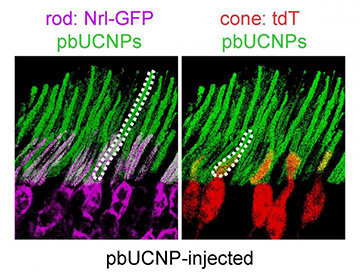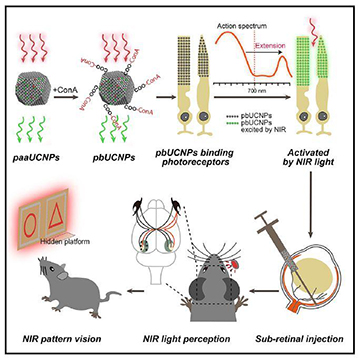
A photomicrograph shows protein-connected upconversion nanoparticles (green), which absorb infrared radiation and re-emit it at visible wavelengths, binding to retinal rods (purple) and cones (red). [Image: Y. Ma et al., Cell, doi: 10.1016/j.cell.2019.01.038]
Researchers in China and the United States have reported the creation of upconversion nanoparticles (UCNPs) that can latch onto retinal photoreceptors and serve as tiny antennae for otherwise invisible near-infrared (NIR) light, converting it into a visible signal (Cell, doi: 10.1016/j.cell.2019.01.038). The research team found that mice injected with the photoreceptor-binding nanoparticles were able not only to perceive NIR radiation, but even to distinguish between different shapes in the dark based only on their NIR signals.
The technique’s effects were reportedly temporary, did not have lasting side-effects, and did not appear to interfere with the animals’ ability to see in the visible spectrum. The characteristics of the approach, according to the team, could lend it to use in “bio-integrated nanodevices” for human NIR detection in security, encryption and other applications, as well as for possible repair of visual function in some natural color-vision defects.
A mammalian limitation
Like other mammals, including humans, mice can see only in the visible part of the spectrum, ranging from wavelengths of 400 to 700 nm. They perceive the visible world through light-absorbing pigments in retinal photoreceptors—the well-known rods, which handle low-light, monochrome vision, and the cones, which are generally responsible for color vision in comparatively brightly lit conditions.
Getting past this limitation, and enabling humans to “see” infrared signals, has typically required the use of bulky prostheses such as so-called night-vision goggles, which detect NIR signals with an infrared sensor and electronically convert the signal to visible (for example, green) light detectable by humans. The goggles work well, allowing their wearers to get around in the dark. But they’re inconvenient to wear, require external power, and quickly become oversaturated when the lights come on.
The researchers behind the new work, led by Tian Xue and Jin Bao at the University of Science and Technology of China and Gang Han at the University of Massachusetts Medical School, USA, hit upon a different approach. Instead of using wearable goggles to convert NIR light to visible light, one could do the same thing by adding a tiny NIR antenna to the photoreceptor itself.
Sticky UCNPs
Upconversion nanoparticles were coated with a polymer and attached to proteins that bound to retinal photoreceptors. Tests showed that the nanoparticles, injected into the retinas of lab mice, allowed the mice to see infrared radiation as green light. [Image: Y. Ma et al., Cell, doi: 10.1016/j.cell.2019.01.038] [Enlarge image]
The team began by chemically creating NIR-sensitive UCNPs—core-shell nanoparticles tuned to have an excitation peak at 980 nm, firmly in the NIR, and to re-emit light at 535 nm, in the green part of the visible-light spectrum. Next, they coated the UCNPs with poly-acrylic acid, to which they then tied a protein strand, concanavalin A (ConA). The researchers chose ConA specifically for its known ability to grab onto sugar residues in the outer segments of the mouse photoreceptors. Spectroscopy confirmed that the ConA strands had bound tightly to the nanoparticles.
The researchers then dissolved the protein-doped nanoparticles in a phosphate-buffered saline (PBS) solution and injected the solution into the sub-retinal spaces of lab mice. The team found that the particles did indeed latch onto the rods and cones of the mouse retinas. Side-effects, such as clouding of the mouse corneas, were comparable to the adverse reactions of other sub-retinal injections, and disappeared within a week or two.
Pupils, shocks and mazes
Next, the researchers put the mice, with their souped-up retinas, through a number of tests, to see what impact the nanoparticles had on their vision. First, they found that the pupils of mice with the nanoparticle-treated retinas contracted when illuminated with 980-nm light, while the pupils of control mice showed no reaction.
Next, they trained both UCNP-treated and control mice to expect a mild shock when confronted with a 20-second green-light pulse at 535 nm, the emission wavelength of the UCNPs, and thus to show a “freezing” behavior upon such a light flash. The treated mice showed the freezing behavior when stimulated with 980-nm (NIR) light or with 535-nm (visible) light, whereas the control mice froze only when stimulated with the 535 light. That clearly indicated that the UCNPs were absorbing the 980-nm light, and converting it to a visible-light signal that could be sopped up by the attached photoreceptors and sent to the mouse brain to interpret.
![]()
In a maze test, mice treated with the nanoparticles were able to distinguish between different shapes projected in only infrared light. [Image: Y. Ma et al., Cell, doi: 10.1016/j.cell.2019.01.038]
Most remarkably, the researchers put the mice to work in a simple Y-maze experiment, in which the animals were trained to respond to different geometrical patterns. The UCNP-injected mice “were able to discriminate NIR and visible-light patterns in the dark environment, whereas non-injected control mice could only detect the visible-light pattern,” according to the researchers. And additional tests revealed that the treated mice’s ability to see NIR-illuminated patterns did not affect their ability to perceive visible-light patterns at the same time.
From nighttime security to vision treatment
The team found that one injection of the nanoparticles gave the mice some level of NIR vision for up to ten weeks after the treatment. And tests months after the treatment, according to the team, suggested that the injections did not cause any long-term damage to the animals’ retinas.
While much additional work clearly remains to be done, the research team is bullish about the prospects for its technology. In addition to creating a potential alternative to night-vision goggles for some military, encryption and security applications, the team points out that, by using different kinds of UCNPs, the treatment could help repair certain vision problems, such as red color-vision defects. And for other eye diseases, the nanoparticles could, the team believes, serve as targeted drug-delivery systems that could release small molecules locally to photoreceptors on stimulation with light of a specific wavelength.
Co-P.I. Geng Han, in a press release accompanying the research, pitched the potential even further. “It is very likely that the sky may look very differently both at night and in daytime,” he said. “We may have the capability to view all the hidden information from NIR and IR radiation in the universe which is invisible to our naked eyes.”

